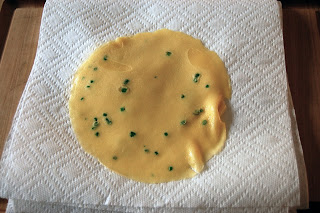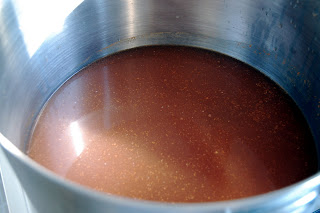"Peas and Carrots" -- Maine Lobster Pancakes with Pea Shoot Salad and Ginger-Carrot Emulsion
First, let's start with some good news: I got my wallet back! Woo-hoo!!!!! It was found and turned in at the Metro station four blocks from where I was robbed. All the cards (including a whopper of a Williams Sonoma gift card) were still in there, and the only cash that was left was one quarter. Hey, big spender.
Anyhoo, I couldn't be more thrilled, because now I'm a two-wallet girl. My old wallet for the regular stuff, and the new bacon wallet to hold all my gift cards and store credits in one place (because right now, they're scattered everywhere and it's annoying).
But enough about me and my accessories. Let's talk about something really important and very official and that is the fact that I am a giant nerd.
Why (this time)?
Because at the Farmer's Market on Sunday, I acutally said, "Oh yay! Pea shoots!"
OUT LOUD.
Not just OUT LOUD, but also kind of loudly -- enough so that people actually turned to look at me as if I were some sort of who knows what. So to that, I say "turn back around people and pay attention to what you were doing before and let me be happy about pea shoots, or else I might have to TUSK you or something."
Actually, I'm sure the reason they turned and looked at me so strangely is because allergy season is kicking my ass, and with all this pollen my exclamation about pea shoots resembled a Harvey Fierstein stage whisper, so they probably thought they had a celebrity in their midst. What a disappointment that they turned around and it was only me. C'est la vie....
I have been dying to do this dish and the salmon dish (coming soon to an Internet near you) because they both involve pea shoots -- which, in case you didn't get it from the words I so lovingly typed above for your viewing pleasure, I love so much.
I made this dish over the course of two days. It could be done all in one, but I have a life, people. Well, not really. I just felt like spacing it out.
The first thing I did was head down to BlackSalt to pick up three lobsters:
I steeped them in boiling water, took them apart, removed the meat for use later, and was left with three lobster bodies:
I cut up the lobster bodies into about 6 pieces each, and put them in a sauté pan with some canola oil. I had them in the pan for about 5 minutes, and then added some tomato, carrots, thyme, and water.
I let this simmer for about an hour and a half. Then, I strained it into another pot, pressing against the solids to make sure all the liquid was released.
I strained the liquid again into a smaller pot, which left me with nearly 2 cups of liquid.
I put the pot o' lobster liquid over medium heat and brought it up to a lively simmer, and reduced it until I had about 2 tablespoons of a thickened glaze.
I noticed there were some solids still in the liquid toward the end, so I strained it again into a smaller pot and finished the reduction (the smell of which was so intensely wonderful, I kind of wish I could afford to do this everyday):
While this was reducing, I prepared the lobster filling. I cut the lobster meat (minus the claw tips, because the texture would detract from the rest of the meat) into a small-ish dice, and minced some shallots and chives:
I mixed this in a bowl, and added a half-cup of mascarpone, some salt and pepper, then added the 2T of the lobster glaze I'd just reduced:
I covered this and put it in the refrigerator overnight. Wanna see a close-up? Of course you do:
The next day, I set out to finish the dish. The French Laundry Cookbook suggests juicing 3 pounds of carrots for the ginger-carrot emulsion, but I don't have a juicer. And, I wasn't going to shell out $200 for one, since I know I would never, ever use it (I generally don't like juice; I'd rather just eat the fruit or vegetable on its own). So, I bought carrot juice and "infused" (infauxed?) it with some fresh, shredded carrots, as well as some fresh, shredded ginger:
I brought this mixture to a boil, then reduced it to a simmer for about 15 minutes.
When it had reduced from 2 cups to about a half a cup, I poured it through a strainer into another saucepan, then whisked in some cream and 12 tablespoons of butter (one by one), then poured it into a blender. I know that the book says not to skim or strain at this point, but I wasn't really making the "correct" version anyhow, so I kind of had to wing it and make it my own from this point on.
I blended it for about 30 seconds and kept it in the glass vessel until I was ready to plate.
The last big step was making the crèpes. Even though I was psyched about this dish because of the pea shoots, I was equally as annoyed about making crèpes. Why? Because I have a history of bad crèpe making. I never seem to get the batter done right, or they're too thick or too thin, or they just end up tasting rubbery and awful. It's really depressing, because I love crèpes. Always have. I went to France for a few weeks after graduating from college, and because we were so poor, my friends and I lived on crèpes. They were about a dollar, and you could get them from these great little crèpe carts on the streets of Paris, filled with whatever you wanted -- ham, cheese, fruit, nutella... the possibilities were endless. The heat would permeate the thin paper they were wrapped in, but on a cold and rainy afternoon, it was an added bonus. Every time I've tried to make crèpes since then has been a disaster. I expected this time to be the same, and was already concocting different final-plating plans for this dish just in case.
I mixed all the ingredients as instructed, poured the batter through a strainer, added the chives, and heated my non-stick sauté pan over low-medium heat.
I poured my first crèpe, ever so gently and tilt-ily rotated the pan and let it cook for less than a minute (probably 30-40 seconds). Then, I lifted one little bit with a small offset spatula, picked up the crèpe with my fingers, and flipped it over:
Not perfect, but not too shabby, eh? This is usually the point at which I find out they're too thin, so they fall apart... or too thick, and they plop like pancakes. This first one looked like maybe, just maybe, I knew what I was doing.
I banged out eight of these, and stacked them in between paper towels as I went:
Right before I started the crèpes, I took the lobster filling out of the fridge, so it could come closer to room temperature before I used it to fill the crèpes.
I laid a crèpe flat on a cutting board, put about 2 T of lobster filling in the center, then folded the edges of the crèpe up over the top until I had a neat, little lobster package. I made eight of them, and placed them on a baking sheet brushed with melted butter, and brushed some melted butter on the tops of the crèpes, then put them in the oven for 10 minutes until they were heated all the way through.
While they were in the oven getting warm, I made sure my ginger-carrot "emulsion" was still warm (it was), and I dressed the pea shoots with a bit of lemon olive oil, salt and some minced shallots.
To plate, I poured a little mini-pool of the ginger-carrot goodness onto the plate, topped it with a lobster-filled crèpe, then topped that with the pea shoot salad.
And, a closer look:
Guys. Gals. And everyone in between. This was freakin' fantastic. Let's start with the ginger-carrot foamy-ish extravaganza. I want soap made of this, and I also want to eat this every day for the rest of my life. If the way I did it was this good, I can't even imagine how amazing it would be to do it Keller's way. Wow. It's hearty and mellow and sharp and strong but smooth and luxurious. Paired with the lobster crèpe? Beyond amazing. Then, a bite of pea shoot along with the lobster-filled crèpe that I slathered with ginger-carrot sauce? So so so so good. Really.... I don't want to sound all haughty and obnoxious, but I was so proud of being able to make something this good.
We all gobbled it up in near-silence, with one of my most finicky tasters chowing down like there was no tomorrow.
While everyone else sat around the table getting caught up on the events of the day, I snuck into the kitchen, took the one remaining crèpe off the baking sheet and debated offering it to whoever wanted seconds. Then, I thought better of it and saved it (along with some of the ginger-carrot sauce) for myself to eat for lunch the next day. Except that I ate it at 11 o'clock that night because I just couldn't fall asleep knowing it was in my fridge, waiting to be enjoyed.
I slept 10 hours that night.
I haven't slept for 10 hours (in a row) in years.
Thanks, lobster crèpe with ginger-carrot fauxmulsion.
Up Next: Citrus-Marinated Salmon with a Confit of Navel Oranges, Beluga Caviar and Pea Shoot Coulis
Resources:
Lobster from BlackSalt
365 canola oil and butter
Produce and most herbs from Whole Foods
Thyme from my garden
Crave Bros. mascarpone
Lakewood organic carrot juice
Organic Valley heavy cream and whole milk
Pea shoots from Calvert's Gift Farm
Eggs from Smith Meadows Farm
King Arthur flour
Music to Cook By: Rodrigo y Gabriela; Rodrigo y Gabriela. It's mesmerizing. Absolutely outstanding. I have the CD in my car and their music on my iPod in the house. It's Mexico and Central America meets Nordic-Irish-Europe with some help from the Gipsy Kings and the steady rhythm of heavy metal. I know I'm not doing it justice. Just get the album and see for yourself. I can't stop listening to it. I was so entranced listening to it in the car the other day, I missed my exit on the Beltway. Doy.
Read my previous post: French Laundry at Home Extra -- Trussing and Roasting a Chicken
























































